African American Abolitionist and Author Harriet Jacobs escaped from slavery and became an abolitionist speaker and reformer. Jacobs’ single work, Incidents in the Life of a Slave Girl, published in 1861 under the pseudonym Linda Brent, was one of the first autobiographical narratives about the struggle for freedom by female slaves and an account of the sexual harassment and abuse they endured. Harriet Ann Jacobs was born in 1813 in Edenton, North Carolina to Daniel Jacobs and Delilah. Daniel was a mulatto slave owned by Dr. Andrew Knox. Delilah was a mulatto slave owned by John Horniblow, a tavern owner. Harriet inherited the status of slave from her mother—if the mother was a slave, the child was a slave. That…

Frances Berkeley
First Lady of Virginia Image: Remains at Green Spring Plantation Frances Culpeper was Virginia’s most notable 17th century woman. The youngest of the five children of Thomas and Katherine Culpeper, Frances was baptized at Kent, England, on May 27, 1634. Her father lost everything in the service of King Charles I, but the Crown rewarded Culpeper by naming him one of the original seven grantees of the 5-million-acre Virginia land grant known as the Northern Neck Proprietary. Thomas Culpeper came to the New World in 1650, hoping to rebuild his fortune. Good Marriages In 1652, Frances married Samuel Stephens, governor of the Albemarle settlement in North Carolina and the owner of Roanoke Island, the site of Sir Walter Raleigh’s Lost…
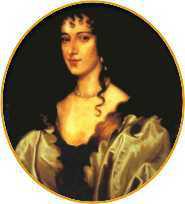
Anne Arundel
First Lady of Maryland Image: Lady Anne Arundel Baltimore Lady Anne Arundel (sometimes spelled Arundell) was born in 1615. She was an English noblewoman, daughter of Thomas Arundel, 1st Baron of Wardour, and a member of the ancient family of Arundels in Cornwall, England. Her father was a wealthy and influential Catholic. In 1628, at the age of thirteen, Lady Anne married Cecil Calvert, 2nd Baron Baltimore, the founder of the colony of Maryland. Of the nine children the Calverts had, only three survived to adulthood, including Charles Calvert, 3rd Baron Baltimore.
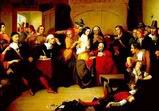
Witchcraft in Connecticut
The Year: 1647 Image: Witchcraft Trial In 1642, witchcraft became punishable by death in the Connecticut Colony. This capital offense was backed by references to the King James version of the Bible: Exodus (22:18) says, Thou shalt not suffer a witch to live. And Leviticus (20:27) says, A man also or woman that hath a familiar spirit, or that is a wizard, shall surely be put to death: they shall stone them with stones: their blood (shall be) upon them. Belief in witchcraft was common in seventeenth-century New England. The infamous witchcraft trials at Salem in 1692 are well known, but if you exclude those, ninety-three complaints of witchcraft were made in New England between 1638 and 1697—forty-three in Connecticut…
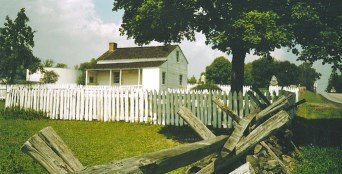
Lydia Leister
Home Used as Union Headquarters at the Battle of Gettysburg On July 1, 1863, Federal troops surrounded the Leister farm – it was in the crook of the fishhook battle line along Cemetery Ridge. When General George Gordon Meade chose the Leister house (image left) as the headquarters of the Army of the Potomac, Lydia and her children sought shelter with relatives who lived on the Baltimore Pike. Lydia Leister was a widow who owned a modest farm along the Taneytown Road, ½ mile south of Gettysburg behind Cemetery Ridge. Lydia had purchased the property in 1861, and moved into the modest two-room house with her six children, the youngest, only three years old. The widow Leister made her living…
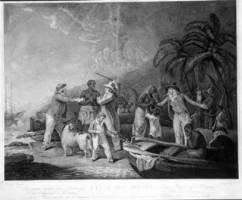
Slavery in Connecticut
The Year: 1639 Image: Buying Enslaved Africans Connecticut had black slaves as early as 1639. In 1650, Connecticut became the second colony after Massachusetts to recognize slavery as a legal institution. The slavery of Africans became a fact of everyday life, and became an accepted system of labor by 1680. Connecticut grew crops, raised cattle, and felled logs to sell in the West Indies, because many Caribbean islands were busy growing the more profitable sugar cane. That sugar cane, produced by captive Africans, was brought north to the Connecticut Colony as molasses and sugar products, which were distilled into rum in such quantities that Connecticut became the New World’s leading distiller.

Slavery in New Hampshire
The Year: 1645 Image: Slave Prayer Meeting New Hampshire’s African heritage dates back to 1645 and centers on the state’s only port at Portsmouth. The first known black person in Portsmouth came from the west coast of Africa. He was captured one Sunday when slave merchants attacked his village in Guinea, killing about a hundred persons and wounding others. Upon arrival in Boston, the slave was bought by a Mr. Williams of Piscataqua. When the General Court of the colony learned of the raid and kidnapping, it ordered the merchants to return the African to his home. Slavery was not the issue of concern—human bondage was legal. The court was indignant that the raiders had violated the Sabbath.
Mary Long Sell Thompson
Widow of Gettysburg I find it quite interesting that the commanders-in-chief of the armies at Gettysburg, Confederate General Robert E. Lee and Union General George Gordon Meade, chose the homes of widows as their headquarters during the battle. Lee’s Headquarters House On July 1, 1863, General Robert E. Lee established his personal headquarters at a stone house on the Chambersburg Pike, just outside of town. The house was owned by Thaddeus Stevens, a Pennsylvania congressman and statesman. Lee’s staff chose that house not only because of this close proximity to the center of the Confederate line, but also because the house’s thick walls afforded the General some physical protection from artillery shells. Lee’s headquarters tents were set up in an…
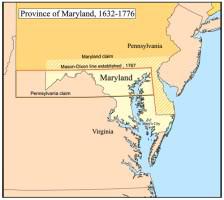
Maryland Colony
Thirteen Colonies A Southern Colony The Province of Maryland was an English colony in North America that was founded in 1632. It began as a proprietary colony of Lord Baltimore, who wanted to create a haven for English Catholics in the New World, and to demonstrate that Catholics and Protestants could live together harmoniously. Although Maryland was an early pioneer of religious tolerance in the British colonies, religious strife between Anglicans, Puritans, Catholics, and Quakers was common in the early years. A Royal Charter Charles I of England granted a charter for about twelve million acres to Cecil Calvert, 2nd Baron Baltimore on June 20, 1632. The charter had originally been granted to Calvert’s father, George Calvert, 1st Baron Baltimore,…
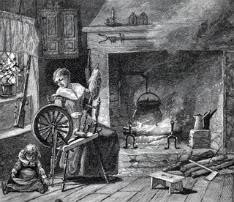
Colonial Women’s Rights Movement
Early 17th Century All references to the Women’s Rights Movement in the United States begin with the First Women’s Rights Convention in 1848. I think that is wrong. I believe the movement began long before that. In fact, I believe it began the moment Mary Chilton set foot on Plymouth Rock. History’s Forgotten Women What about the Women on the Mayflower? Were these not brave women? Did they not brave the uncertainties of the New World—never knowing what dangers they would encounter? Did they not play a vital role in building the New England Colonies? Did they not work alongside the men to create this great country of ours?